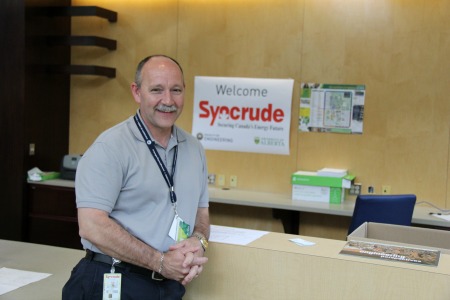
Home away from home: Syncrude's Long Range Planning area leader Mark Wyllie (Mining '87) greets visitors in the reception area of the Engineering Teaching and Learning Complex where Syncrude staff members set up temporary working spaces.
(Edmonton) The University of Alberta and Alberta's oil sands industry have a long history of discovery and application of new knowledge and technologies. The hot-water technology developed by engineering professor Karl Clark in the 1920s led to the processes used to separate oil from sand today. Clark's was the first of countless innovations developed through partnerships between the oil sands industry and academics.
So when wildfires forced the evacuation of Fort McMurray in May, the Faculty of Engineering reached out to industry supporters to offer help. That assistance took the form of providing office space for about 150 displaced Syncrude employees, who spent more than a month working in offices in the Engineering Teaching and Learning Centre.
As the Syncrude staff prepared to return to Fort McMurray, the faculty and industry staff held a mixer where industry professionals could meet with professors and graduate students to discuss research and industry needs.
"A lot of our staff visit the Faculty of Engineering fairly regularly," said Peter Read (Mining '86), Syncrude's vice president of strategic planning. "For example, our advanced control team members are here frequently meeting with professor Biao Huang (NSERC Senior Industrial Research Chair in Control of Oil Sands Processes) and on the mining side, we have a high percentage of our employees who earned their degrees at the U of A."
Another strong tie between Syncrude and the Faculty of Engineering is the co-op program. Engineering students in the co-op program often accept paid positions with Syncrude, and this spring those hired students remained on the company's payroll throughout the evacuation.
"We made the decision as a company to maintain their employment," said Read. "We chose not to treat them differently than any other employee. They continued working, but doing very different things until we got back to work on site."
While conversations at the mixer focused on work and the enormous tasks Syncrude had ahead, there was also a strong social and heartfelt colour to the discussions.
Read, who has served on the faculty's Mining Industry Advisory Committee since 1990, said the Syncrude staff was given everything it needed on campus.
"What we got from the U of A was above and beyond anything we imagined. Every time we inquired about something, the answer was "Yes." And that will not be forgotten."
Being able to work together with colleagues made each individual far more productive he added, and it helped bring a sense of normalcy to the lives of the technical professionals and engineers who were working in the ETLC building.
If there is a silver lining to the crisis, it is in the fact that it has brought teams of people closer together, he said.
"A lot of these teams usually work in different buildings and have different focuses. One good thing that has happened is we now have people from different parts of the company meeting each other and working together. There will be long-term benefits of having these people work together, even for a short time."
"Being able to come into work every day and be productive brought back a sense of normalcy," said Mark Wyllie (Mining '87), area leader, Long Range Planning. "We get so much more done working together than if we were all working on our laptops at hotels or a friend or family member's house."
Wyllie served as co-ordinator of the Syncrude staff during their stay in the ETLC office space. He was "amazed" at how accommodating the Faculty of Engineering was, finding enough desks and chairs to squeeze three or four people into offices. Five Syncrude employees sat at tables inside the office space once occupied by the dean of engineering.
The logistics were complex, but every request was met, he said.
"We do a lot of hiring of new graduates from the U of A and they know their way around here. Some of them were using the big screens to do their work down in the mining design lab where they were doing school assignments a few years ago."
Wyllie says there were personal benefits to working on campus as well that helped people cope with the crisis.
"What this has also done is given us an opening to tell our stories-just getting out of the city during the evacuation was a major event for all of us-and we've been able to talk about what happened and it helps us try and move on."
At the mixer, both Read and Dean of Engineering Fraser Forbes commented on the support and collaboration being a testament to the strength of the relationship between the university and Syncrude and thanked everyone involved in making it happen.
"The U of A was there for us as we faced the biggest challenge in our company's history," Read said. "That generosity made a real difference for many people in a time of significant adversity. Thank you all."